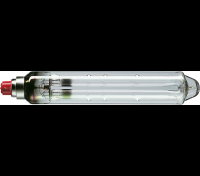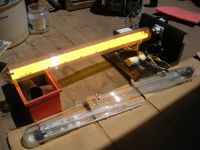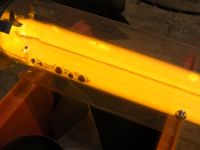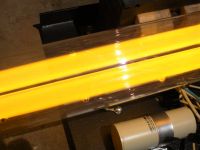
Close look at low pressure sodium lamp. And milli-ohmetering.
klugesmith, Mon Jun 11 2018, 11:58AMLast month, the 277 volt parking lot lights at work were changed from sodium to LED. Facility manager had the old luminaires stacked by the dumpsters. Pile gradually dwindled to nothing, but not before I took a couple home to play with. (Each unit is 14.1 x 48.5 inches.)
The T21 light bulbs are new to me. Most are 180 W size, like Philips SOX 180. D=66 mm, L = 1120 mm.
32,000 lumens. 176 lm/W - I bet the LED's don't beat that.
Color temp 1800 K, with color rendering index near zero. The astronomers on Mount Hamilton like that.
New lamps go for more than $100 each. Mfr's literature
 has an image Photoshopped to eliminate most of the length!
has an image Photoshopped to eliminate most of the length!
Here's the ballast I got Friday night, from the very last luminaire. Its 43" long lamp was broken. Here replaced with a stubby 29" lamp previously salvaged from a different unit. Yellow glow hurts the eyes to look at, even in bright sunlight.

The U-shaped arc tube has little dimples in which sodium can condense. There's always condensed metal in there, even if molten. I think Na is one of those metals (like Hg) with exceptionally low vapor pressure at its melting point. It's chemically transformed when the tube breaks and fills with air!

Near the cathode ends, there's a progression of metal amounts in the dimples.

Does the story of getting 277V power, and measuring resistance of a steel electrical conduit for safety grounding, belong here?
Re: Close look at low pressure sodium lamp. And milli-ohmetering.
ShieldExperiments, Tue Jun 12 2018, 02:07AM
So with the dimples in the glass that the sodium pools up in taken into consideration, are these lamps intended to be operated in a certain orientation?
Also, is the 'progression' you mention due to particle accelerator-like migration of the sodium droplets? [if you'll excuse my crude analogy]
ShieldExperiments, Tue Jun 12 2018, 02:07AM
So with the dimples in the glass that the sodium pools up in taken into consideration, are these lamps intended to be operated in a certain orientation?
Also, is the 'progression' you mention due to particle accelerator-like migration of the sodium droplets? [if you'll excuse my crude analogy]
Re: Close look at low pressure sodium lamp. And milli-ohmetering.
klugesmith, Thu Jun 14 2018, 06:40PM
The Philips datasheet (link in OP) says the lamp orientation must be horizontal +/- some practical number of degrees. IIRC, it doesn't explicitly say the two sides of U-tube need to be in same horizontal plane, as found in these luminaires. Is there any reason to want them in a vertical plane (90° rotation around lamp axis)? Maybe if you wanted to direct maximum candlepower sideways, without using any reflectors.
My guess is that over thousands of hours of operation, the sodium will tend to migrate to the coolest places on the tube envelope, and the dimples are there to be cool spots. Might there be a small energy barrier to nucleate condensation of vapor at a new place, compared to free metal surfaces that already exist?
klugesmith, Thu Jun 14 2018, 06:40PM
The Philips datasheet (link in OP) says the lamp orientation must be horizontal +/- some practical number of degrees. IIRC, it doesn't explicitly say the two sides of U-tube need to be in same horizontal plane, as found in these luminaires. Is there any reason to want them in a vertical plane (90° rotation around lamp axis)? Maybe if you wanted to direct maximum candlepower sideways, without using any reflectors.

My guess is that over thousands of hours of operation, the sodium will tend to migrate to the coolest places on the tube envelope, and the dimples are there to be cool spots. Might there be a small energy barrier to nucleate condensation of vapor at a new place, compared to free metal surfaces that already exist?
Re: Close look at low pressure sodium lamp. And milli-ohmetering.
Hazmatt_(The Underdog), Sun Jun 17 2018, 05:04PM
They probably don't want to deal with a lawsuit if they print that the tube can be used in a vertical orientation.
They're probably worried that someone will use the tube in a vertical orientation, with the electrodes at the bottom whereby the sodium can puddle up and cause the lamp electrodes to flash-over during startup, and possibly cause the tube to rupture, or kill the transformer.
Or .. at some point the lamp may just not start if the sodium shorts the filaments.
Would be interesting to find out why.
Hazmatt_(The Underdog), Sun Jun 17 2018, 05:04PM
They probably don't want to deal with a lawsuit if they print that the tube can be used in a vertical orientation.
They're probably worried that someone will use the tube in a vertical orientation, with the electrodes at the bottom whereby the sodium can puddle up and cause the lamp electrodes to flash-over during startup, and possibly cause the tube to rupture, or kill the transformer.
Or .. at some point the lamp may just not start if the sodium shorts the filaments.
Would be interesting to find out why.
Print this page